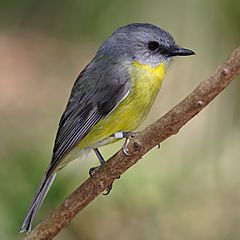Songbird facts for kids
Quick facts for kids SongbirdsTemporal range: early Eocene to present
|
|
|---|---|
 |
|
| Eastern yellow robin (Eopsaltria australis) | |
| Scientific classification | |
| Kingdom: | |
| Phylum: | |
| Class: | |
| Order: | |
| Suborder: |
Passeri
|
Songbirds are a large group of birds known for their amazing singing abilities. They belong to a special group called Passeri, which is also known as 'oscines'. The word 'oscines' comes from Latin and means 'songbird'. These birds are a true clade, meaning they all share a common ancestor.
There are about 4,000 different species of songbirds! They have a special vocal organ called a syrinx that lets them make many different and beautiful sounds. Songbirds are very successful and are the most common type of bird on Earth today.
Scientists believe songbirds first appeared about 50 million years ago. They likely evolved in the ancient landmass called Gondwana, which later became places like Australia, New Zealand, New Guinea, and Antarctica. From there, they spread all over the world.
Why Do Songbirds Sing?
Songbirds sing for several important reasons. Their songs are mainly used to mark their territory. This means they tell other birds who they are and where they are. Songs also show what a bird intends to do, like if it's looking for a mate.
For male songbirds, having a wide variety of songs can be a big advantage. Females in some groups prefer males with a larger "song list." The more songs a male knows, the more females he might attract!
Besides singing, birds also make shorter sounds called "calls." These calls are used for things like warning others about danger or staying in touch when birds are flying or feeding in groups. While most birds make some kind of call, only songbirds and a few other bird groups have truly developed songs.
Songbird Families
Songbirds are divided into many different families. Scientists group them based on how they are related. Here are some of the main groups:
Corvida Group
This group used to be considered a main division of songbirds, but scientists now know it's not a true clade. This means the birds in this group don't all share a single common ancestor that isn't also shared by birds outside the group. So, it's not used in modern bird classification anymore.
However, many interesting bird families were once part of this group, including:
- Lyrebirds: Known for their amazing ability to mimic sounds.
- Bowerbirds: Males build elaborate structures to attract mates.
- Honeyeaters: Birds that feed on nectar.
- Australian magpies: Common and intelligent birds.
- Birds of paradise: Famous for their colorful feathers and unique mating dances.
- Crows, rooks, ravens, magpies, and jays: Very smart birds often found in this group.
Passerida Group
This group is considered a true clade, meaning all the birds in it share a common ancestor. It includes many of the songbirds you might see every day.
Some examples of families in the Passerida group are:
- Larks: Known for their beautiful songs, often sung while flying.
- True sparrows: Small, common birds found worldwide.
- True finches: Often kept as pets, known for their varied songs.
- Cardinals: Brightly colored birds, especially the males.
- Mockingbirds: Famous for mimicking the songs of other birds.
- Nuthatches: Birds that climb headfirst down tree trunks.
- Wrens: Small, active birds with loud songs.
- Swallows and martins: Graceful birds that catch insects in flight.
- Bulbuls: Medium-sized birds found in Asia and Africa.
- Starlings: Often seen in large flocks, known for their mimicry.
- Thrushes: Birds with beautiful, flute-like songs.
See also
 In Spanish: Passeri para niños
In Spanish: Passeri para niños

